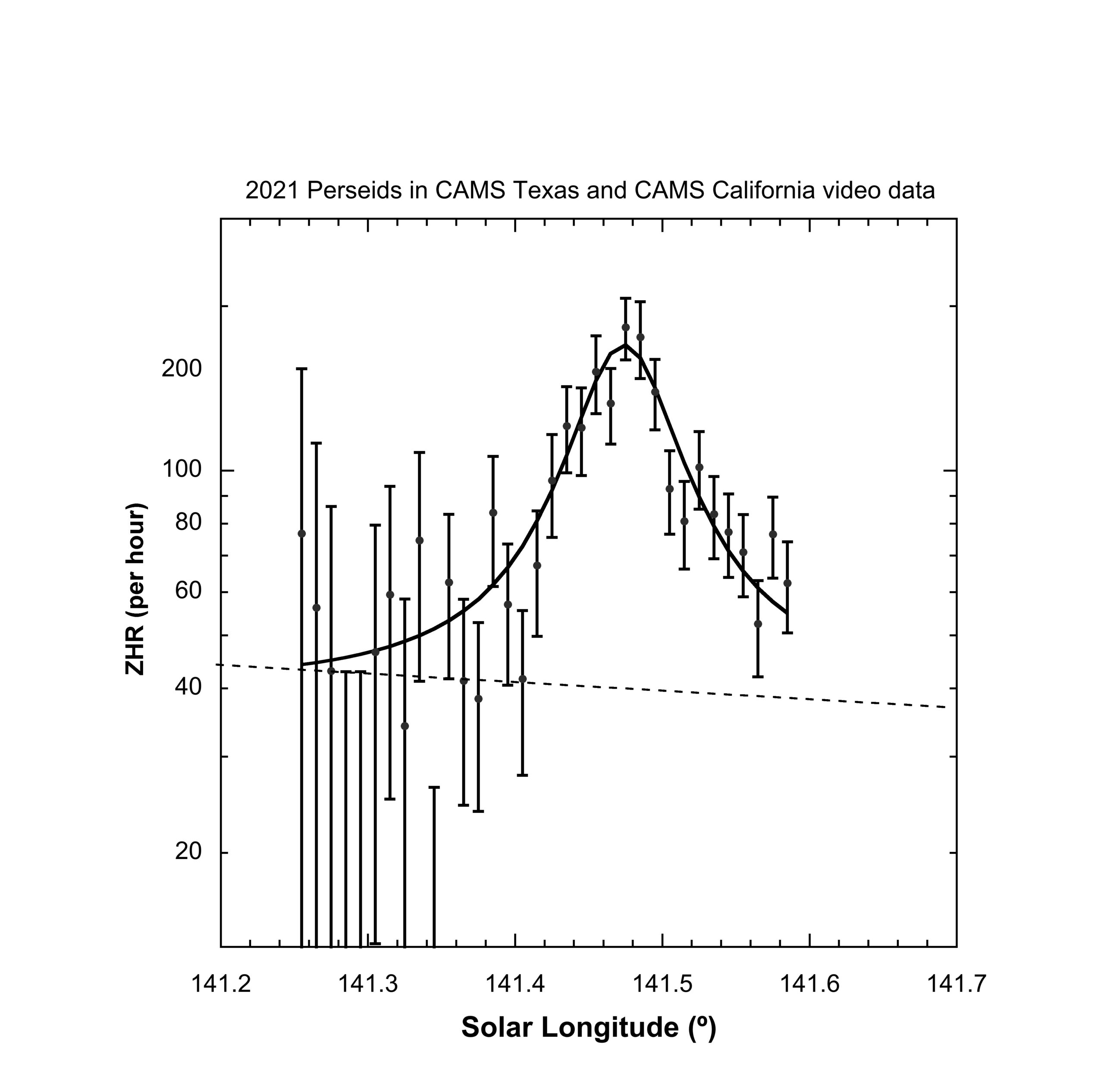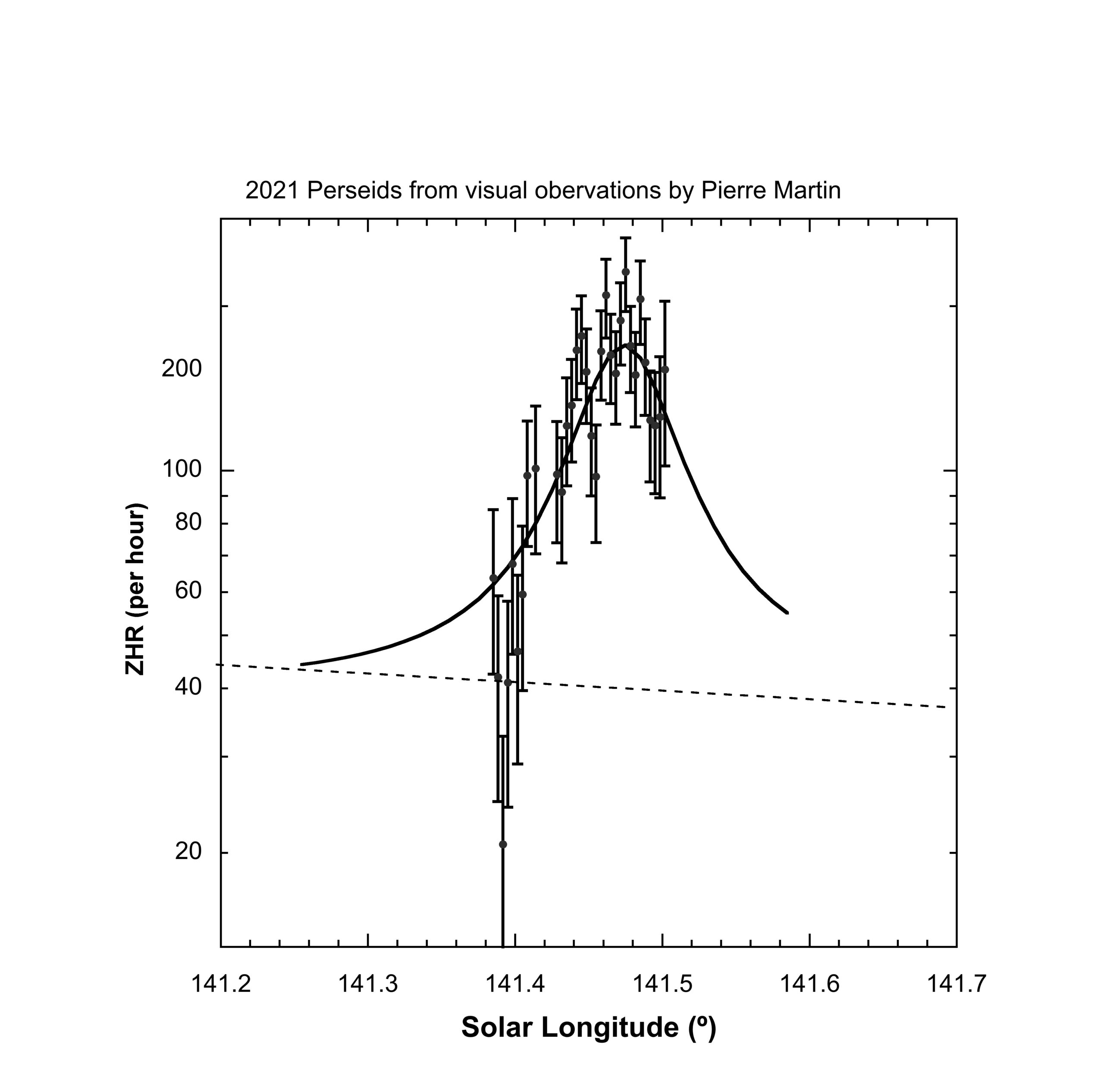Peter Jenniskens, Koen Miskotte
Abstract: An unexpected outburst of Perseids was detected by low-light video observations on August 14, 2021. The outburst peaked at solar longitude 141.474 ± 0.005 degrees (equinox J2000.0) and the activity profile had a Full-Width-at-Half-Maximum of 0.08 degrees solar longitude and a peak rate of ZHR = 130 ± 20 per hour above the normal ~45 per hour annual Perseid activity. The Perseids had a steeper magnitude size distribution index than the normal annual shower component. The activity profile is similar to that derived from visual and forward meteor scatter observations. This activity may be related to the earlier smaller enhancements observed in 2018 and 2019.
1 Introduction
In 2018, visual observers reported a narrow peak of Perseid shower activity around solar longitude 140.95°, about ~30 hours after the traditional Perseid maximum, with a peak of about ZHR = 25 per hour above the normal Perseid activity of ZHR ~ 45 per hour at that time (Miskotte 2019). In 2019, a similar peak was recorded by forward meteor scatter observations collected by the International Project for Radio Meteor Observation. That year, the outburst peaked at solar longitude 141.02° with a peak ZHR ~30 per hour above normal activity (Miskotte 2020a; 2020b). Here, we report the detection of a more significant outburst on August 14, 2021 (Jenniskens, 2021). This outburst was not anticipated from known 109P/Swift-Tuttle dust trail encounters.
2 CAMS Low-light video observations
The Perseids are best observed from the northern hemisphere. The 2021 outburst happened between 6h and 12h UTC on August 14, 2021 , at a time best suited to the CAMS video-based meteoroid orbit survey networks in the United States. The networks triangulated meteors using low-light video cameras and determined the meteor’s radiant and speed in a continuous night time surveillance. The weather was mostly clear for networks in Texas (coordinated by W. Cooney and including D. Selle, F. Cyrway and J. Brewer) and California (P. Jenniskens, D. Samuels, J. Albers, E. Egland, B. Grigsby and J. Wray). CAMS Mid-Atlantic (coordinated by P. Gural), CAMS Florida (A. Howell), CAMS Arkansas (L. Juneau) and LO-CAMS in Arizona (N. Moskovitz) also observed some of the meteors under partial clear skies (c.f. CAMS-website for date of August 14).
Early results from the new CAMS Texas network in mostly clear skies and the CAMS California network in clear skies show an activity profile with peak Zenith Hourly Rate ZHR = 130 ± 20 per hour on top of normal ZHR = 40–45 per hour annual Perseid activity (Figure 1). The Full-Width-at-Half-Maximum of the fitted Lorentzian profile is 0.08 ± 0.01 degrees solar longitude. The peak occurred at solar longitude 141.474 ± 0.005 degrees (equinox J2000.0), corresponding to 8.2h UTC on August 14. The combined magnitude distribution index was 3.59 ± 0.36, compared to 2.94 ± 0.04 for the annual component in other years at this solar longitude.

Figure 1 – 2021 Perseid rates according to CAMS Texas and CAMS California video data. The vertical scale is logarithmic. The dashed line is the level of normal annual Perseid activity.
3 Comparison to other observations
Pierre Martin, visually observing from Ottawa, Canada, reports “multiple Perseids per minute with many bursts, sometimes 3-4 in a second”, starting at 6h UTC. He observed until 9h UTC, under clear skies with star limiting magnitude 6.7. From his 5-minute interval counts, we calculated a peak ZHR = 210 ± 20 per hour at solar longitude 141.474 ± 0.005 deg. The visually observed meteors follow the video data profile well (Figure 2).

Figure 2 – 2021 Perseid outburst from visual observations by Pierre Martin in Ottawa, Canada.
This outburst was also confirmed by radio forward meteor scatter observations posted by H. Ogawa of the International Project for Radio Meteor Observation. A compilation of rates from 49 observers in 14 countries saw the detection count increase above normal levels after 6.4h UTC (141.40 deg solar longitude), and peak at about 8.8h UTC (141.49 deg) at a level of 3 times the Perseid peak level, before declining to normal levels at 12.5h UTC (141.65 deg solar longitude). Combined Zenith hourly rates peaked around ZHR = 210 per hour, in good agreement.
The outburst can not be identified yet with a known dust trail crossing from 109P/Swift-Tuttle. On the other hand, the width of the outburst is similar to that of past Perseid Filament returns (Jenniskens, 2006). The Filament is thought to be an accumulation of dust in mean-motion resonances from many past returns. That could perhaps mean that this dust was directed into Earth’s path this year. These observations may help better understand the origin and evolution of that dust component.
References
Jenniskens P. (2021). “Perseid meteor shower outburst 2021”. CBET 5016, 2021 August 14, editor D.W.E. Green.
Jenniskens P. (2006). “Meteor Showers and their Parent Comets”. Cambridge University Press, Cambridge, UK, 790 pp.
Miskotte K. (2019). “Perseids 2018: an analysis of the visual data”. eMetN, 4, 135–142.
Miskotte K., Vandeputte M.(2020a). “Perseids 2019. Another peak around solar longitude 141.0°?”. eMetN, 5, 25–29.
Miskotte K. (2020b). “Perseids 2020: again, enhanced Perseid activity around solar longitude 141?” eMetN, 5, 395–397.


I witnessed the outburst while casually watching the shower in 6.6 Lm skies near Wilno, Ontario, Canada. Didn’t do a proper count but subjectively I estimated the outburst must have had a ZHR of ~150 with a peak at 4:54 a.m. EDT when 8 meteors per minute were seen, a rate I had not seen since the 2001 Leonids. As reported by others, at times 3-4 meteors appeared nearly simultaneously. Observed from 3:30-4:15 a.m. EDT seeing roughly 200 Perseids. Best Perseid shower I’ve seen since the mid-1990’s.
Correction: make that 3:54 a.m. EDT, Aug 14th, 2021.